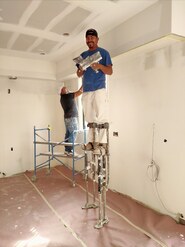Eugene WilliamsThe DIY Dad http://diydad.info/  Buying a fixer-upper can be great. Think about it: You can buy a rundown house in a fantastic neighborhood for cheap, put some money into fixing it up, and soon you could have a home tailor-made to your tastes that is worth far more than you put into it. However, buying a fixer-upper can also be fraught with risk, especially for first-time homeowners. While it might seem relatively simple to fix up a rundown home, older homes can be teeming with unseen problems. A house might look rundown yet fixable on the outside, but what if the plumbing and electric are shot? What if the whole roof needs to be replaced (the national average cost of a roof replacement is $6,750)? When you add in this risk of the unknown with the fact that many home buyers spend more on a fixer-upper than they can reasonably afford, you have a recipe for disaster. Follow these simple steps to ensure that your fixer-upper experience goes as smoothly as possible.  Figure Out How Much You Can Spend Like we previously stated, many homeowners tend to spend more on a fixer-upper than they can afford. When payments are spread out over a longer period of time -- $2,000 for new appliances here, $1,000 for new flooring over there -- many people overestimate how much money they can reasonably spend and find themselves out of money with a half-finished home. One of the most common mistakes regarding fixing up an older home is not budgeting enough money. Skimping on your budget and biting off more than you can chew can cause you to cut corners, hire shady contractors, and purchase cheap material once you realize that your money doesn’t stretch as far as you originally thought. To avoid this situation, make sure to estimate your home affordability before purchasing a fixer-upper. According to Dave Ramsey, your monthly mortgage payment should be no more than 25 percent of your income, including taxes and insurance. Don’t forget to include the current APR in your calculation and subtract your down payment from the listing price!  Tackle Necessary Projects First There is no point of hanging light fixtures if you don’t have a floor, and you can’t precisely begin painting the walls if you need to repair the drywall. If you can, you should try to avoid houses with structural, electric, or water problems. These repairs are often costly and don’t do much to increase the value of your home. Instead, find a home that only needs cosmetic repairs to get the most bang for your buck and spend the least time renovating. If you don’t plan to remain in the home for more than a few years, stick with moderate renovations. You won’t get your money back on high-end upgrades in a mid-priced neighborhood. Before beginning your remodeling, check local real estate listings for homes comparable to your expected final product. Their prices can help you determine your renovation budget. In Carmel, IN, the median sales price for a home is $438,000.  Decide Whether to Stay or Sell Once your home is done, it is time to decide whether you should stay in your newly renovated home or sell it. Selling your fixer-upper for a profit can be extremely irresistible. However, it is important to remember that not all potential buyers will appreciate your repairs. Often, fixer-uppers are renovated to suit the tastes of their owners and might not appeal to the broader community. In other words, not everyone is going to like your outdoor shower or Zen garden. Before you consider selling your home, you should also think about whether you have the endurance to renovate another house or not. Renovations can take months or even years. Are you ready to go through that again? Buying a fixer-upper can be exciting, but it also comes with a considerable amount of risks. Following this guide can help you side-step potential downfalls at every step of the renovating process and will hopefully make your fixer-upper experience go smoother. Comments are closed.
|
Archives
July 2024
Categories
All
|


 RSS Feed
RSS Feed
